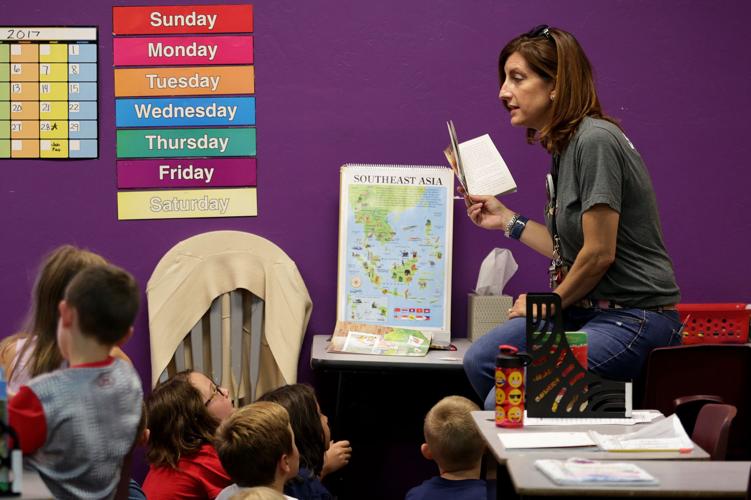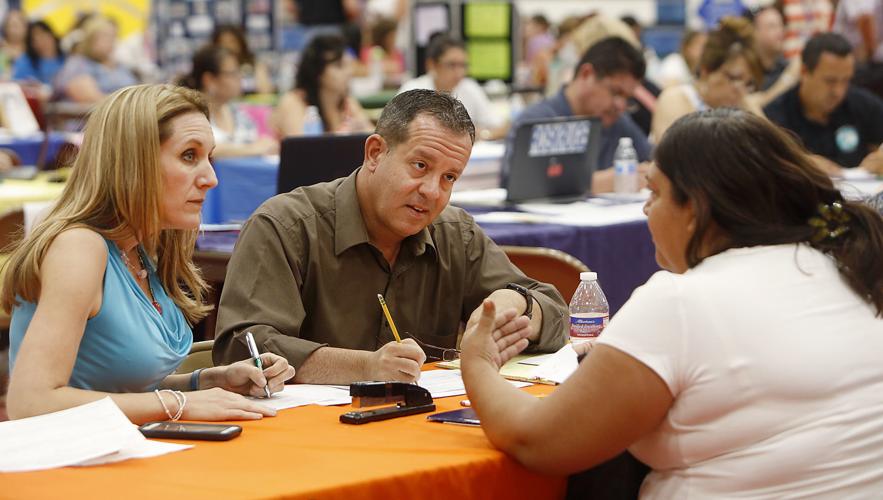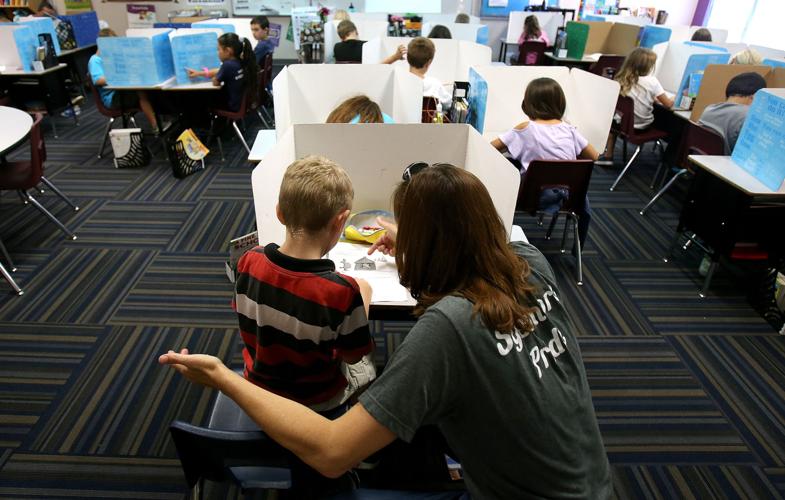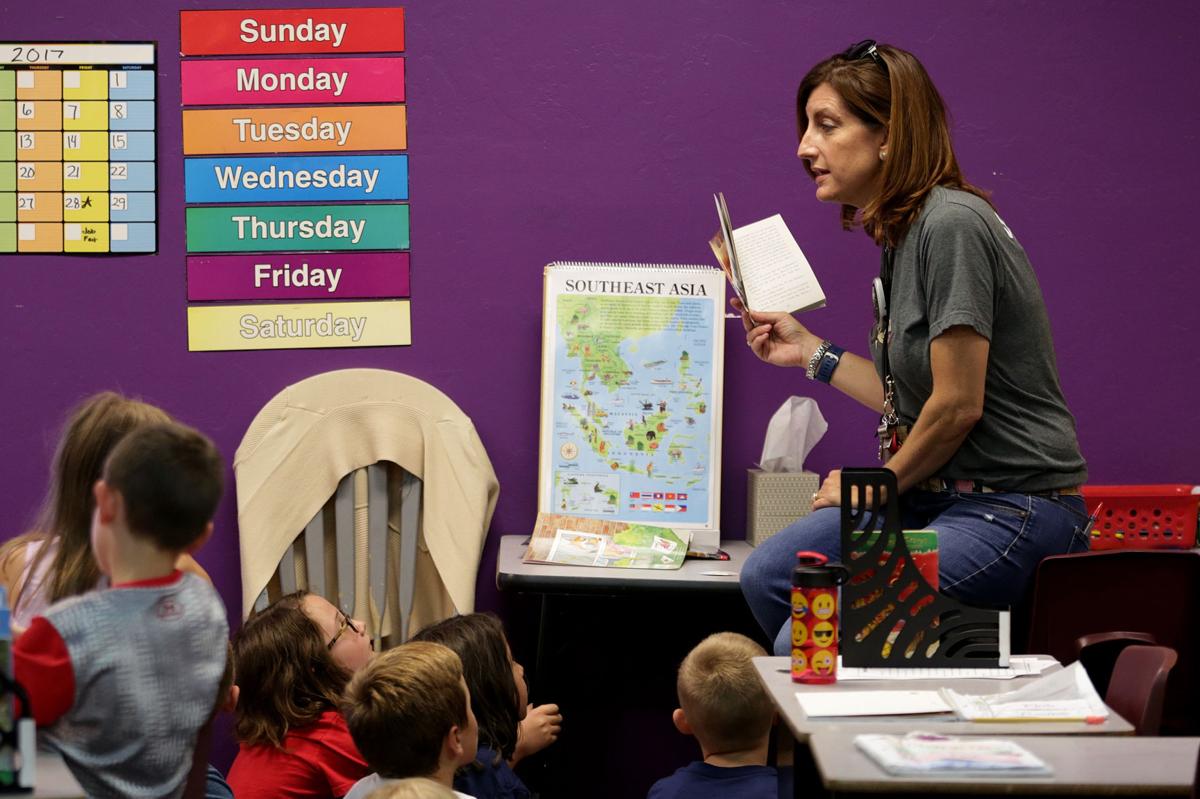As Tucson-area school districts struggle to fill classroom teaching positions, most have decided against an option signed into law by Arizona Gov. Doug Ducey — hiring people without any formal teacher training.
What is this law?
In a nutshell, SB1042, which was signed by Gov. Doug Ducey in May and goes in effect Aug. 9, allows districts to hire people who want to teach but don't have formal training.
Applicants don't need a bachelor's degree to be considered, as long as they can prove they have five years of experience in the field they wish to teach.
Previously, there were mechanisms in place to fill teacher vacancies through emergency and substitute teacher certifications but a bachelor's degree was required to obtain those certifications.
Even those with a bachelor's degree, but no official teacher training might be lacking in the basics of teaching though and it takes time to learn, said Renee Clift, Professor and Associate Dean at The University of Arizona College of Education.
"By the time you're in your third or fourth year, you know what you're doing," Clift said. "It's a little bit like driving a car."
Training means teachers don't have to learn on the job.
"High quality teacher programs help people understand the basics, gives them a chance to practice, gives them feedback and consultation, Clift said. "We give them chances to expand but all in a very safe environment because they're not the teacher on record."
Diane Douglas, Arizona's state superintendent of public instruction, says the reason she is not a supporter of the new policy is that it might put people in the classroom that are not as prepared as they should be.
"What I've not wanted to see is that we lowered standards for teachers in classrooms. Where education swings on a pendulum," Douglas said. "There was a philosophy that if you knew how to teach you could teach everything and now it seems we're swinging in another direction that says if you know your content area, you don't need to understand management or other things as much, but to me, both pieces are vitally important."
Which local districts are using uncertified teachers?
The Vail School District, recognized as one of the top achieving district's in the state, however, has decided to give non-certified teachers a shot, putting 40 people with no formal training into classrooms.
As a result, Vail started the new school year two weeks ago with no vacancies in a regular classroom.
"That was a huge accomplishment," said Vail Superintendent Calvin Baker. "If you look at what's happening in other school districts in the county ... often students were starting the school year with a substitute teacher. We had to do that in the last couple years and we managed to avoid that this year and we did that because in part we had access to a larger pool of candidates."

Kristy Gossen gets her second-graders' attention with hand signals in her classroom at Sycamore Elementary School, 16701 S. Houghton Road, on July 28, 2017, in Corona de Tucson, Ariz. This is the first year school districts can hire teachers without certification. Gossen was a substitute teacher for nine years prior to her first full-time teaching position this year.
The Vail School District isn't just hiring any person who walks in.
Of Vail's 24 elementary alternative-certification teachers, 17 have children who attend school in the district.
"I think that's a really important statistic because it indicates that the alternative teachers we are hiring, most of them are not just somebody we met or just on a fluke decided to apply and we hired because we are desperate," Baker said. "These are people we know because their children are going to school here and often their principal said 'you should apply.' And these are people who know us and who have trusted their children to us and have a very strong commitment to making sure our schools are of high quality."
Baker says the reason it's so difficult to hire certificated teachers is because of Arizona's low teacher wages.
"There are not many teachers who are attempting to support a family on their teacher salary," Baker said. "In essence, our pool, if you will, of candidates is smaller because of that restricted demographic. So when we open it up to people pursuing non-traditional ways to teach then we expand our pool so that we can find people that meet our high standards for teaching here in Vail."
All teachers who are newly hired in Vail attend a two-year new teacher induction and are assigned a mentor teacher.
"We took that one step further this year because we realize we have teachers that were coming to us, many of them without teaching experience," Baker said. "So every teacher in the alternative certificate program, has a direct coach. That is somebody who has a relationship with them who would be somewhat similar to a teaching supervisor. They come in on a regular basis and are very direct saying 'you need to do this, you need to change that' to provide an increased level of supervision and direct feedback."
As those teachers demonstrate they have their feet on the ground and are moving in the right direction, they are graduated into the district's regular coaching arrangement.

Kristy Gossen helps a student with their reading formative in her second grade classroom at Sycamore Elementary School, 16701 S. Houghton Road, on July 28, 2017, in Corona de Tucson, Ariz. This is the first year school districts can hire teachers without certification. Gossen was a substitute teacher for nine years prior to her first full-time teaching position this year.
Long-term substitutes are still the answer for several districts
Tucson Unified School District says it makes every effort to hire certificated teachers. But if there are still vacancies at the beginning of the school year, the district will use certified long-term substitutes to teach until a certificated teacher can be recruited.
As of July 26, TUSD, which employs 2,598 teachers, had 120 teacher vacancies.
"We're big advocates of teacher certification programs, believing that teaching kids is an art and you learn that in teacher education programs" said TUSD's interim superintendent, Gabriel Trujillo. "I don't want to make the assumption that someone without certification would be bad for kids. There are a lot of wonderful adults who would do well by kids ... I would say they wouldn't be as effective as a teacher as somebody who is fully certified."
The district offers teacher mentors with intern certificates and also offers a "Make the Move" program which promotes employees without a teaching certificate to obtain one and become a teacher.
Last year, Sunnyside Unified School District employed 67 teachers with long-term substitute certificates.
"All of our teachers are certified, whether through traditional teacher certification, Alternative Pathways and/or substitute certification through the Arizona Department of Education," said Victor Mercado, Sunnyside spokesman. "We have a strong Alternative Pathway to certification which we use to cultivate and develop teachers through partnerships with UA South, Pima College, Grand Canyon University and other colleges, universities and programs who offer alternative certification programs for professionals to pursue teacher certification. Our substitute community is not a parallel track, but a pathway and a space for passionate individuals to enter the teaching profession and practice their craft. Like many of our partner districts in the state, we face challenges in staffing teachers in the lower grades, math, science and special education."
Flowing Wells School District will not be implementing the new policy at this time, said Superintendent David Baker.
The Catalina Foothills District feels the same way.
"We want to hire highly qualified teachers, not individuals who have no teacher training," said Mary Kamerzell, the district's superintendent, in a written statement. "If we make the decision to hire a non-credentialed person, for whatever reason, there must be a development plan that moves that individual to full certification."
Other ways to tackle the teacher shortage
TUSD's superintendent, Gabriel Trujillo, says to fill vacancies, recruitment needs to start much sooner.
"You can't have the campaign kicking off in January and February," Trujillo said. "What we know now is you've got to start recruiting as they're in their final semester. That is a really big strategy that has proven effective."

Jessica Harris, assistant principal at Safford K-8 Magnet School, and Justin Freitag, a learning support coordinator, interview Yolanda Estrada, far right, for a position as a Spanish teacher at a 2015 Tucson Unified School District job fair at Catalina High School.
But, Clift says it's more about retaining people than recruiting.
"Within the U.S., and even in Arizona, we have plenty of certified teachers," Clift said. "They're just not teaching. ... Salary in Arizona is huge and if people have the option to leave, they do."
Arizona loses more than 40 percent of new teachers within the first three years, according to Douglas, due to Arizona's low wages and lack of support in the classrooms.
She hopes to get teachers an 11 percent pay raise and an additional $100 million a year for school repairs through a full-cent sales-tax increase.
One of the biggest things districts can do to tackle the shortage is creating opportunities for expanded stipends and salary increases, especially in targeted areas of shortage like math, special education, ESL and reading specialists, Trujillo said.
Giving teachers freedom to be creative in classrooms is one way to retain them, Clift said.
"Once teachers have learned the basics, allow them to be creative and continuously work on meeting the need of all the children," Clift said. "The ability to be creative and innovative is one thing that keeps people in the profession."
Changing the law about who can be a teacher isn't the final solution, said Vail's Calvin Baker.
"This is not the solution," Baker said. "It's the way we are dealing with the problem and we're dealing with it constructively, but teachers need to make more."
Whether SB1042 will be successful or not is a matter of time, Douglas said.
"But unfortunately, when time tells if it's not successful or as successful as we hope from the onset — what happens to those children in the meantime?" Douglas said. "That's always my concern."
Here's a breakdown on how many uncertified teachers each district plans to hire this school year
Amphitheater Public Schools
July 17:
Total teaching positions: 803
Vacancies: 22
Uncertified: 0 (as of July 17 but that could change in an emergency situation)
Catalina Foothills
July 7:
Total teaching positions: 310
Vacancies: 12
Uncertified: 0
Flowing Wells
July 10:
Total teaching positions: 296
Vacancies: 0
Uncertified: 0
Marana Unified
July 14
Total teaching positions: 674
Vacancies: 18
Uncertified: 0
Sahuarita
July 20:
Total teaching positions: 339
Vacancies: 3
Uncertified: 0
Sunnyside
July 18:
Total teaching positions: 802
Vacancies: 16
Uncertified: 0
Tanque Verde
July 17:
Total teaching positions: 111
Vacancies: 5
Uncertified teachers: 0
Tucson Unified
July 19:
Total teaching positions: 2,598
Vacancies: 142
Uncertified teachers: 0
Vail
July 17:
Total teaching positions: 744
Vacancies: 3
Uncertified teachers: 40








